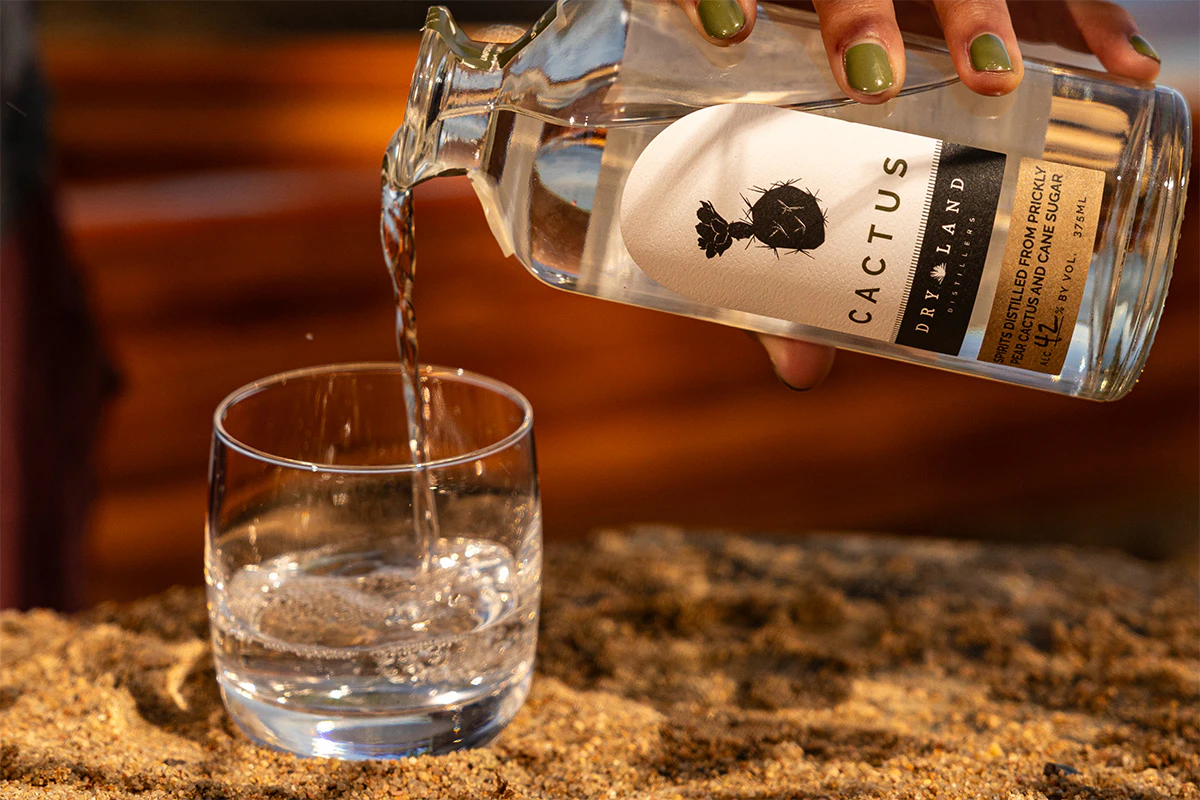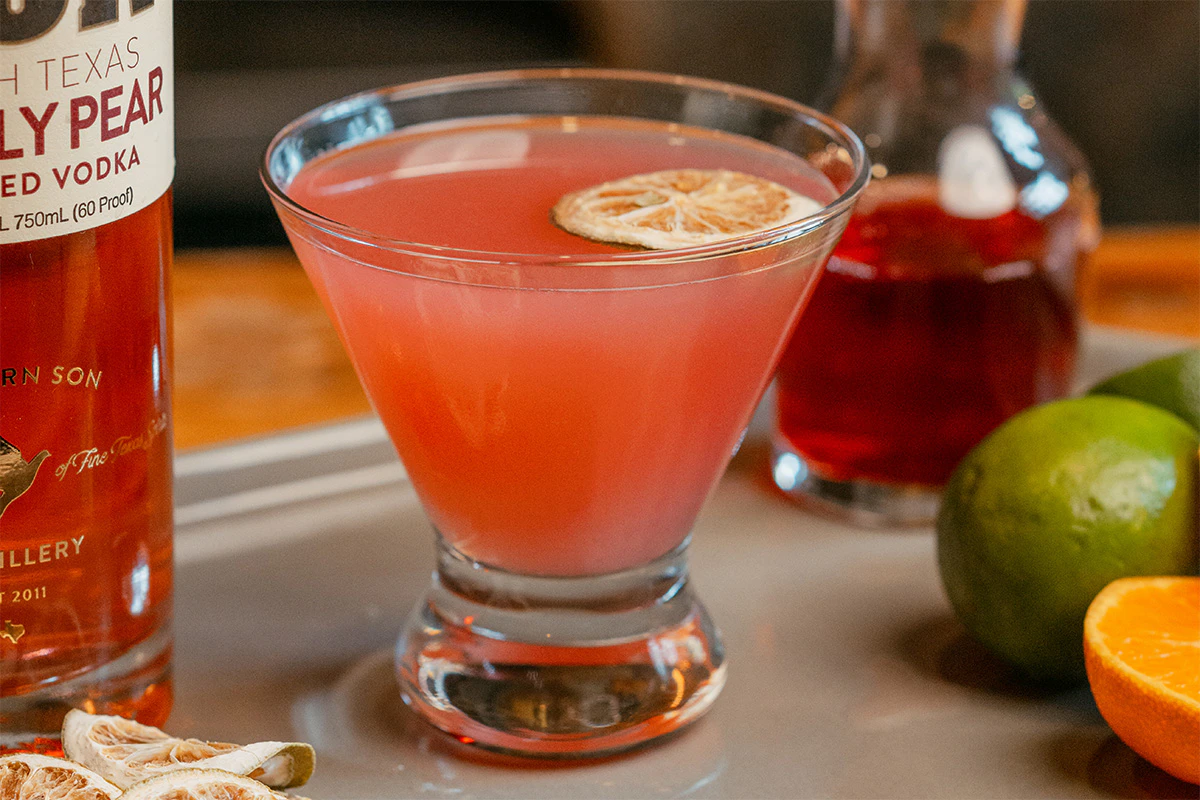“Cactus” and “spirit” in the same sentence may make some think of agave—also a succulent that occasionally gets confused with the cactus. Yet some distillers are working with true cactus, capturing the plant’s particular flavors and celebrating the regions where it grows.
These distillers are nearly always working with the fruits or pads of the prickly-pear cactus, also known as opuntia or nopal. Their creations take a variety of forms—from sweeter, vibrantly pink liqueurs to strong, smoky spirits not unlike mezcal.
Whatever the form, these distillers are tapping into some unique advantages: Agave spirits are popular, and that appreciation is a natural bridge into cactus spirits; they represent a new playground of flavor, and there are opportunities for storytelling around certain regions and their biodiversity.
There are also challenges to working with prickly pear, from sourcing it to extracting enough fermentable sugars. However, for those who want to bottle the flavors of the desert and offer drinkers something new, the juice of the prickly pear is worth the squeeze.
Smoky and Familiar
One day—not long after opening Dry Land Distillers in Longmont, Colorado, in 2018—founder-distiller Nels Wroe was out hiking and had to stop to pull needles from his border collie’s paws.
“When I was first envisioning Dry Land,” Wroe says, “I was really focused on creating spirits that were authentic to the American West and to Colorado.”
Those cactus needles led to a lightbulb moment: Prickly pears were all around. Intrigued, Wroe found a retired Colorado State University professor who’d been working for five years to establish the local prickly pear as a commodity.
“It’s a phenomenal plant for Colorado,” Wroe says. “It requires almost no water, is low-impact, grows in terrible soil conditions, creates great habitats, and attracts beneficial insects.”
The spirit Wroe developed calls for the pruned pads of the prickly-pear cactus, so that there’s no need to kill entire plants. He’s partnered with growers in different regions where the cactus grows, including Arizona and Texas as well as Colorado.
“The growers who grow for us also grow for restaurants,” Wroe says. “They use the young cactus pads for food-grade supply and toss the older pads, which is what we’re taking. So, we’re using a waste product and paying them for it.”
For a 50-gallon batch of spirit, Wroe starts with a 1,000-pound mash that includes about 800 pounds of prickly-pear pads. The exact amount depends on the season—in summer, the cactus bulks up on water and nutrients, but it’s leaner in winter. That difference can lead to variable yields.
The cactus pads contain enzymes that help to break down their own complex carbohydrates, or starches, into simpler sugars. Wroe employs a low-temperature smoke-and-cook process to activate these enzymes and catalyze this conversion. Still, the pads don’t offer as much sugar as grain does.
“We’re about 60 percent from what you’d see from a grain-based spirit, on yields,” he notes. When working with the pads in winter, he balances their lower amount of complex carbohydrates with about 25 percent raw cane sugar. After lautering, Dry Land sends the remaining cactus solids to farmers for hog feed. The cactus-pad wash, meanwhile, ferments for five to seven days before distillation.

Courtesy Dryland Distillers, Longmont Colorado
The finished flavor profile of Dry Land Cactus Spirit captures a mezcal-like smokiness; it’s smooth and balanced, with a bright hint of citrus sweetness to counter the smoke, with fresh, earthy, celery-like vegetal notes. Wroe also ages some of the spirit for three to 12 months to create Cactus Reposado, and for one to three years to create Cactus Añejo—the spirit becomes less smoky, creamier, and sweeter with age.
Wroe says he worked with the TTB to help get prickly pear onto the FDA’s Generally Recognized as Safe list to get approval. The spirit remains tricky to categorize; competitions have placed it against everything from mezcal to “other,” alongside liqueurs and mixers. That hasn’t hindered the accolades: Cactus Spirit is a Good Food Awards winner and a gold medalist at the Denver International Spirits Competition.
Clean but Earthy
The Austin-based High Desert Vodka brand also set out to make a spirit with prickly pear, but within the framework of vodka.
High Desert cofounder Logan Sligar says he was drinking a prickly-pear margarita in 2017 when he realized the plant is all over Texas—a visible symbol that conveys the state’s landscape, climate, and culture. Working in construction and real estate at the time, he had no background in distilling, but he was determined to create a spirit from this recognizable succulent.
Sligar partnered with a Texas distillery to start experimenting. They tried the cactus pads but didn’t feel they were getting enough sugar, so they moved on to the tuna, or the fruit. Eventually, High Desert switched to another distillery to scale up production and had to look beyond Texas to source the prickly pear.
“If we used vendors from the United States, we’d have to charge $300 a bottle,” Sligar says. “So, I started learning Spanish and calling every grower in Mexico.”
Roberto Garfias, one of the largest prickly-pear growers in the world, was among those who picked up the phone. In the central Mexican state of San Luis Potosí, Garfias’s ranch has no irrigation, and he uses no pesticides or fertilizers; the cactus grows well without much intervention. Workers harvest the fruits from July to September—like the buds, the tuna also regrow. It’s a more sustainable process than that of agave spirits, for which entire plants must be killed.
One kilo (a little more than two pounds) of fruit goes into each bottle of High Desert Vodka. A distillery about 45 minutes from the ranch de-husks and juices the fruit into a purée; Sligar says the fruit is fibrous and tough to work with. They ferment it slowly over two weeks then triple-distill it before filtering and bottling.
Sligar says they’ve refined their process since first launching in 2023. His aim is to maintain the distinctive character of the cactus while still offering the clean neutrality of vodka. At first, he says, some consumers were unsure whether to approach it like a tequila or vodka, so they distilled it further to lean into the latter. Clean and smooth, High Desert Vodka still boasts hints of the plant’s earthy, fruity, vegetal character. As a result, it works as well in tequila cocktails as it does in vodka drinks.
Fruity and Pure
On California’s central coast, Ventura Spirits is another brand that’s taken the untraditional fruit down a more traditional path.
Opuntia is a prickly-pear brandy, crafted in the truest definition of the style—Ventura purées the cactus fruit, ferments it, and distills it. For Ventura, using prickly pear came from a desire to work with regionally significant plants and flavors.
“Prickly-pear cactus is ubiquitous where we are,” says Ventura cofounder Henry Tarmy. “We’re constantly looking at [the plants] ... and Ventura Spirits is very interested in letting our region—both farmers and the natural world—inform what we make in a meaningful way.”
Like other American distilleries initially inspired by their immediate surroundings, Ventura shifted its sourcing to Mexico to more easily scale up production. Tarmy says they work with a family farm in Aguascalientes, in central Mexico. They receive a full truckload of the plant and work through it over several batches. They ferment the purée with an ester-forward yeast, aiming to capture and accentuate as many flavor compounds from the prickly pear as possible. They then distill the results twice.
The finished brandy is 100 percent prickly pear—a pure expression of the plant.

Courtesy Western Son Distillery, Pilot Point, Texas
Punchy and Colorful
The prickly pear cactus is a powerful flavor source even when it’s not directly fermented and distilled.
Western Son Distillery in Pilot Point, Texas, aims to harness “Texas fruits” to flavor its different vodkas, says VP of marketing Erin King. While sourcing to scale pushes the distillery to look beyond local—a familiar story among American brands working with prickly pear—King says that Western Son Prickly Pear Flavored Vodka still reflects the brand’s Texas location and Southwestern theme.
“There are not many prickly-pear spirits available, and [ours] has this beautiful color that’s easy to market,” she says. People are initially intrigued by the cactus element, she says, then they’re pleasantly surprised when they taste the prickly pear’s familiar flavors evoking watermelon and bubblegum.
Prickly pear’s color can indeed be a selling point if incorporated into the spirit. The hues of pink, purple, or red are enticing, evoking berries or melons. That helps to grab the consumer’s attention, but then quality is necessary for repeat purchases—and King attributes Western Son’s success to the care they give their base spirit.
“A lot of flavored vodkas use inferior bases because people figure, ‘Well, it’s flavored, it will all be covered up,” she says. “We take our base very seriously—it’s 100 percent American corn, 10 times distilled.”
Sweet and Sicilian
Prickly pear cacti aren’t confined to the Americas—at least, not since the 15th century. Christopher Columbus took it back to Spain from the Indies, mistakenly believing he’d gotten it from India—hence the plant’s name in Sicily, fico d’India.
The cactus thrives in Sicily, where it’s been everything from an accessible food staple to an aloe vera–like skin treatment throughout the centuries. Paesano’s Liquore al Fico d’India explodes with sweet, juicy fruitiness balanced by a touch of earthiness and hint of acidity.
“Our idea was to take this ingredient and be able to preserve it by placing it in a liqueur, making it possible to send this all over the world and tell the story of Sicily and its authentic flavors,” says Paesano CEO and founder Giuseppe Cinquerrui. He says the liqueur is a lasting, portable way to celebrate Sicily’s biodiversity and culinary impact. (Paesano also makes liqueurs with artichokes, pistachios, pomegranates, lemons, and melons.)
Prickly pear grows “everywhere, even among the rocks” in Sicily, Cinquerrui says. To rely on a consistent supply, Paesano partners with farmers in the Sicilian towns of Biancavilla and San Cono. The latter was the first town there to begin planting and harvesting prickly pear at an industrial scale.
Paesano first makes a prickly-pear juice, filtering it “many times,” Cinquerrui says. They then use it to infuse a neutral grain spirit via cold extraction, to access the most intense, authentic flavors possible without wasting energy. They use a small amount of sugar to stabilize the blend and let it sit for two to five days, so any pulp separates out.
Cinquerrui says the prickly-pear liqueur is at the heart of the brand’s mission to more widely broadcast the flavors of Sicily. While they’ve spread to large retail accounts as far as Australia—he says they’re now working on U.S. distribution—there are plans for a tourist-friendly tasting room near Taormina, near Mt. Etna, where they can connect prickly-pear liqueur to the local landscape.
Ultimately—even when faced with the reality of sourcing from elsewhere for consistent, scaled production—prickly pear offers complex, delicious flavors as well as an evocative bridge to desert surroundings.
